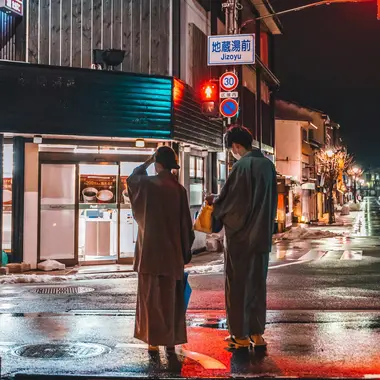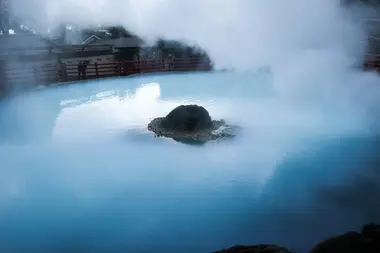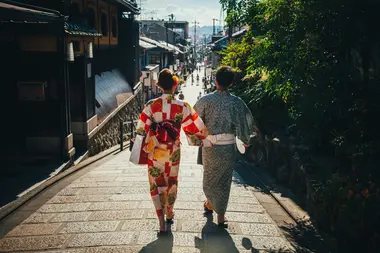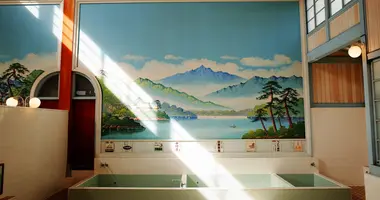Mixed onsen in Japan
- Published on : 25/11/2024
- by : Rita El.manaa
- Youtube
A unique experience of well-being and tradition
Onsen (natural hot springs) are a veritable institution in Japan, symbolizing relaxation, culture and communion with nature. While most onsen are segregated by gender, some establishments offer mixed baths(konyoku), an ancient tradition now less common but still imbued with a unique charm.
What is a mixed onsen?
A mixed onsen, or konyoku onsen (混浴温泉), is a hot spring where men and women bathe together in the same pool. Unlike conventional gender-segregated onsen, these establishments allow for more social or family interaction, and often in an exceptional natural setting.
However, with changing mores and the westernization of Japanese society, mixed-gender onsen have become more rare. Today, they mainly attract lovers of storied traditions and visitors that are curious to discover a different facet of Japanese culture.
A cultural heritage in decline
Historically, mixed onsen were the norm. Inhabitants of the same village came to wash and relax after a day's work, with no separation between the sexes. This way of life reflected a collective and natural vision of nudity, where the human body was simply considered in its primary function.
However, the influence of Western culture in the Meiji era (1868-1912) led to greater modesty in social practices, resulting in the gradual separation of baths. Today, mixed onsens are rarer and often located in rural or mountainous areas, far from the big cities.
Rules to observe in a mixed onsen
Bathing in a mixed onsen can be intimidating for the uninitiated, but following certain rules will ensure a pleasant experience for all:
- Wash before entering the bath: As in any onsen, it's imperative to shower to cleanse yourself before plunging into the thermal water.
- Wear a towel: Unlike separate onsens, most mixed onsens allow (or require) you to wear a small towel or light swimsuit for privacy.
- Respect the peace and quiet of others: Discretion is key, so avoid loud voices or inappropriate behavior.
- Accept local traditions: Each establishment may have its own specific rules, so it's always a good idea to find out before you visit.
Why choose a mixed onsen?
- Immersion in nature: Mixed onsen are often located in the open air(rotenburo), offering breathtaking views of mountain landscapes, forests or rivers.
- A unique social experience: They enable couples, friends or families to enjoy the thermal bath together, which is not possible in separate baths.
- An immersion in Japanese tradition: These establishments preserve a part of Japanese history and culture that few tourists have the opportunity to discover.
Recommended places to discover mixed onsen
Here are some of the best mixed onsen in Japan for this authentic experience:
1. Takaragawa Onsen (Gunma)
Located on the banks of a river, this establishment is famous for its vast outdoor baths surrounded by mountains. It offers a soothing, rustic atmosphere. Towels are provided for comfortable mixed bathing.
2. Sukayu Onsen (Aomori)
Known for its huge wooden mixed bath called "Hiba Sennin Buro", this onsen in northern Japan offers a traditional, authentic atmosphere.
Tip: women-only hours are also available for added comfort.
3. Kurokawa Onsen (Kumamoto)
Nestled in the mountains of Kyushu, this onsen village offers several establishments with mixed baths. The picturesque setting and varied options make it an ideal place for a relaxing getaway.
4. Nyuto Onsen (Akita)
This famous complex features several traditional ryokans. One of them, Tsurunoyu Onsen, offers mixed baths in a historic, natural setting.
5. Hirauchi Kaichū Onsen(Kagoshima)
This unique bath lies directly in the ocean and is only accessible at low tide. An unforgettable experience for adventure seekers.
The challenges facing mixed-gender onsens today!
Despite their charm, mixed-sex onsen face several challenges:
- Cultural prejudice: Some Japanese and foreign tourists are reluctant to the idea of mixed sex in a nude context, even though it is practiced respectfully.
- Local regulations: Some onsen have been forced to separate by gender due to social pressures or to attract a wider clientele.
- Preservation of traditions: The remaining mixed-gender onsen are struggling to maintain their authenticity in the face of modernization and changing visitor expectations.
Tips for preparing your visit
- Find out in advance: Some mixed onsen require reservations or have special rules.
- Opt for quiet hours: Visiting during the week or in the morning often guarantees a more peaceful experience.
- Be prepared to step out of your comfort zone: Mixed onsen can be intimidating at first, but it offers a memorable experience.
Mixed onsen are much more than just a bath: they embody a precious facet of Japanese culture, blending tradition, nature and conviviality. Whether you're looking for authenticity or simply curious about a unique experience, these thermal baths will offer you an unforgettable moment of relaxation in the heart of Japan.






